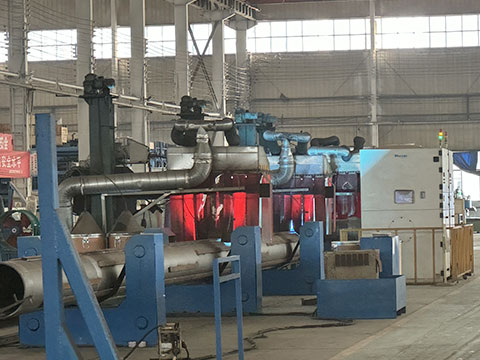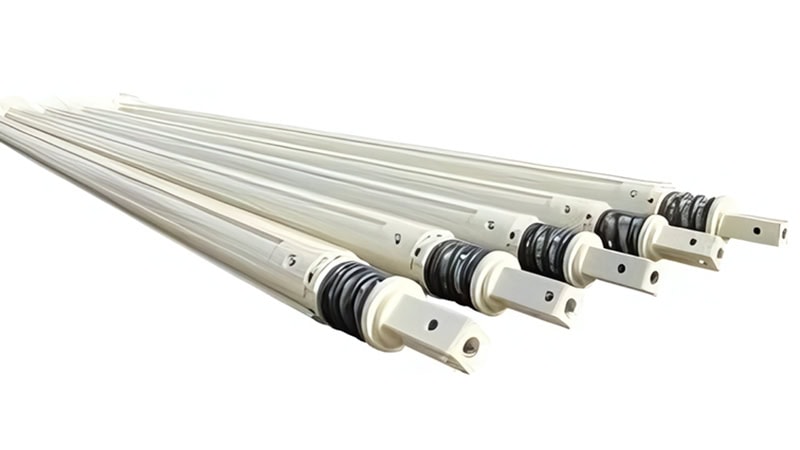
Key Takeaways
- Custom Kelly bars, including interlocking and friction types, enhance torque transfer, reliability, and efficiency across diverse project types and bore conditions.
- Kelly bar adapters and telescopic bars provide compatibility across various rigs, supporting flexible and precise operations.
- Material selection, structural design, and reinforced features with lock recesses ensure durability under high torque and extended cycles.
- Regular maintenance, proper handling practices, and drill pipe customization service maximize performance and service life.
Customization is essential as rig technologies advance and drilling challenges differ across projects, from urban foundations to heavy infrastructure. A Kelly bar is a drive component that transmits torque and axial force from the drill rig to the drilling tool, enabling precise and efficient boring.
Everstar applies technical expertise to design Kelly bars that are compatible, allowing them to adapt to varied rig configurations while complying with origin and quality certificates. You will find in this article why customization matters, including material selection, structural design, manufacturing processes, safety features, and compatibility.
The Function of Kelly Bars in Drilling
A Kelly bar is a specialized drive rod used in hydraulic rotary drilling rigs to transmit torque and vertical load from the rig’s rotary drive to the drill bit. The Kelly bar compression, managed through the lower pipe orifice, helps control crowd pressure for precise boring.
Kelly bars ensure steady penetration, reliable torque transfer, and adapt to different drilling depths. They coordinate rotation and vertical load with the crowd system concurrently, maintaining uniform torque and efficient advancement throughout the bore. Designed for repeated extension to their full extended length, they ensure reliability during long or complex drilling cycles.
A common misconception is that Kelly bars are equivalent to standard drill pipes. Unlike drill pipe compression, which primarily conveys rotation or drilling fluid, Kelly bars handle maximum torque and axial loads, making them essential for heavy-duty applications.
Interlocking Kelly Bars: Performance in Complex Projects
Interlocking Kelly bars maintain alignment along the same axis, with a long guiding structure allowing the crowd system to operate concurrently across multiple sections. Telescopic Kelly bars and lock devices support extended drilling cycles, minimizing misalignment and delivering reliable performance.
Project Applications for Friction Kelly Bars
Friction Kelly bars advance primarily by their own gravity, providing down pressure during drilling. The torque is transferred via drive keys, not friction. These Kelly bars are generally suitable for projects in moderate ground conditions and moderate depths, supporting efficient, reliable drilling operations.
Differences Between Kelly Bars and Drill Pipes
Kelly bars are specialized drive rods, distinct in material, structure, and function. High-strength steel and precise geometries allow them to manage torque and axial loads safely, providing reliability in heavy-duty applications.
Drill pipes primarily transmit rotation or drilling fluid and lack load-bearing and extension capabilities. Correct identification prevents misuse and ensures efficient drilling operations.
Why Customization Matters for Rig Requirements
Generic components can create challenges in demanding projects. Large-diameter piles, deep bores, or specific torque requirements call for a Kelly bar type tailored to hydraulic rotary drilling rigs, sectioning, and equipment attachment setups.
Custom solutions ensure proper fit, efficient torque transfer, and reliable performance. They reduce downtime, prevent premature wear, and support precise boring where standard components cannot meet high-load or complex requirements.
Industry Examples of Customization
At Everstar, we manufacture custom-engineered Kelly bars designed for optimal compatibility with the industry’s leading rotary drilling rig brands. We apply technical expertise to create compatible solutions that adapt to various rig configurations. This specialization ensures seamless integration with major brands, including Bauer, IMT, Jintai, Mait, Sany, Soilmec, Sunward, XCMG, Zoomlion, and Yutong.
To ensure a proper fit, it is crucial to customize critical specifications, including Kelly bar type, section count, length, diameter, and torque capacity to match the rig and drilling tool. Customization of length and section count is also essential. As the target drilling depth eventually determines these specifications, standard Kelly bars may feature up to 6 sections and support depths up to 130 meters.
Our expertise enables solutions tailored to extreme requirements and challenging environments: A Kelly bar was designed with a maximum of eight sections, allowing for a drilling depth of 56 meters.
Materials, Structure & Manufacturing Processes

Kelly bars consist of high-strength steel alloys such as 35CrMo, 30CrMo, ZT600, and Q550. Material selection affects torsional strength, durability, and performance under repeated extension and retraction, making advanced alloys essential for demanding drilling operations.
Structural design—including seamless versus non-seamless pipes, section count, rib design, and overall length—influences torque distribution, rigidity, and penetration efficiency. Correct engineering ensures optimal load transfer while minimizing bending or misalignment during hole formation.
Everstar’s Engineering Advantages
Proprietary features like reinforced drive keys, precision shot blasting, reinforced terminal joints, and retaining rings improve durability and torque transfer. Non-essential coatings, such as hard chrome plating, are omitted to prevent interference with equipment engagement and reduce unnecessary costs.
The manufacturing sequence incorporates precise processes such as removing the interior stress of the pipe, adjusting straightness, automatic welding, and pressure casting. To enhance wear resistance and structural integrity, processes like quenching and tempering are utilized.
These engineering choices enhance reliability and the lifespan of Kelly bars while maintaining compatibility with modern rotary drilling equipment. The design ensures consistent performance under maximum torque and large-diameter conditions, and it includes high load capacity features such as disc springs, shock-absorbing springs, and spiral springs.
Compatibility & Adaptation: Adapters and Beyond
Kelly bar adapters enable connection with major rig brands, including Bauer, Sany, XCMG, and Soilmec, among others. Alignment, torque transfer, and section compatibility are key considerations for reliable operation across different machines.
Custom adapters allow seamless integration with various rig models and equipment attachments. Properly designed solutions prevent misalignment, reduce wear, and provide maintenance solutions, particularly for projects involving multiple rig types or complex drilling conditions.
Common Adapter Configurations
Typical configurations include flange, threaded, and interlocking adapters, each suited for specific rig connections. Everstar emphasizes precision engineering and flexibility to maintain torque integrity and mechanical stability under operational stress.
Adapters accommodate different section lengths and rig models without compromising performance. This approach minimizes installation errors, reduces downtime, and enhances efficiency across construction scenarios.
Everstar’s additional adapter options for customizing Kelly bars include:
- Hydraulic Round Pile Breaker & Pile Cutting Machine
- Hoisting Swivel Elevator for Rotary Drilling Kelly Bar
- Water Plate for Kelly Bar of Rotary Drilling Rig
- Kelly Stub For Rotary Drilling Kelly Bar
- Driver shell for Kelly bar
- Damping Spring for Kelly Bar
- Drive Adaptor Is to Support The Kelly Bar
- Casing Oscillator For Kelly Bar
Ensuring Safety, Quality Guarantee & Longevity

Manufacturing processes such as quenching and tempering directly influence wear resistance and structural integrity. Combined with rigorous quality control, these treatments maintain safety, reduce maintenance, and extend service life in diverse construction environments.
All manufacturing and operational practices follow industry safety standards, aligning with guidelines such as those provided by OSHA to ensure worker safety and compliance on site.
Optimized materials, high-load capacity components, and integrated shock-absorbing springs improve fatigue strength and minimize operational failures. Addressing these factors ensures consistent performance under high loads, supporting long-term reliability and safe boring practices.
Real-World Lifespan Gains in Drill Rigs
Extending the Kelly bar lifespan requires quality materials, precise design, operational controls, and regular upkeep programs. Advanced alloys, reinforced sections, and proper handling reduce failure rates and improve service intervals.
Operational strategies such as good operating habits, torque monitoring, lubrication, and inspection routines complement engineering improvements. Together, these measures enhance durability, maximize performance, and support efficient project execution in demanding drilling depth applications.
FAQ – Customizable Kelly bars for Drilling Tools
What is a Kelly bar in piling?
A Kelly bar is made up of inner and outer sections constructed from high-strength steel, transferring torque from the rig’s power head drive sleeve to the drill head. It supports precise boring, accommodates the depth of drilling, and includes a construction reinforcement ring structure for reliability.
What is the Kelly drilling process?
The Kelly drilling process rotates the bar through the Kelly box, applying torque and axial load to the drill head under strict control. It forms the bore while maintaining alignment, minimizing wear on outer surfaces, and ensuring hole quality within the maximum allowable value.
How do you customize a Kelly bar for different rigs?
Customization selects Kelly bar, section count, adapters, and material to match the rig and drilling tool. Features like telescopic Kelly bars, reinforced keys, and lock devices ensure proper torque, alignment, and compatibility with key components, providing a guarantee of quality.
What are the main types of Kelly bars?
The main types are interlocking and friction bars. Interlocking Kelly bars keep alignment across multiple segments for heavy-load bores, while friction Kelly bars advance on their own gravity downward. Both may include welding seam reinforcement and reinforced ring sections for durability.
When should you replace a Kelly bar?
Replace a Kelly bar if wear on drive ribs, misalignment, or reduced torque transmission occurs. Deformation, compromised outer surfaces, or performance below the maximum allowable value indicate the need for replacement. Good operating habits and inspections maintain operational reliability.
Conclusion: Next-Generation Kelly Bars for Evolving Rigs
Understanding the importance of Kelly bars consists of delivering reliable performance across diverse rigs, ensuring precise torque transfer and consistent operation under challenging conditions. Everstar emphasizes adaptability, material durability, and sectional design to address moderate- and heavy-duty drilling requirements.
Selecting the right Kelly bar requires evaluating rig specifications, project depth, and soil conditions. Contractors should consider sectioning, adapters, and alignment to maintain efficiency, prevent wear, and ensure safe, precise boring where standard components cannot meet operational demands.
Consult Everstar for Your Kelly Bar Solution
Consult Everstar Machinery’s specialists for project-tailored Kelly bars and guidance on key components, customization, and integration with rotary drilling equipment.
Download the latest catalog to explore specifications, quality guarantees, and maintenance solutions, ensuring performance and an exceptional buying experience.